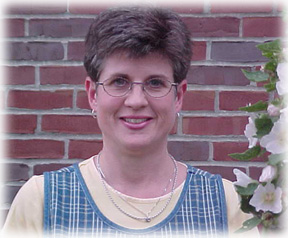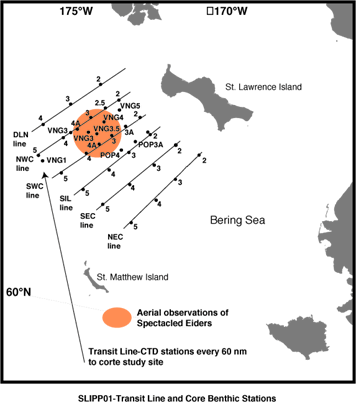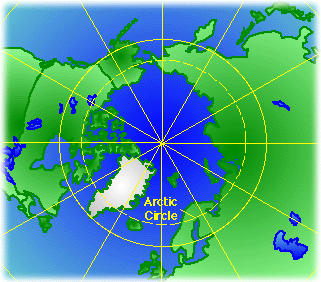
|
|






I have been a kindergarten teacher in Knoxville, Tennessee for 10 years with experience working with children from birth to grade 5 for 12 years prior to that time. I am also an AIMS (Activities Integrating Mathematics and Science) National Consultant. I have the opportunity to work with both children and teachers. Why would a kindergarten teacher be interested in the Arctic? Children have a natural curiosity of the world around them. These formative years are the best times to stimulate excitement regarding mathematics and science. Young children's minds are active and eager to learn. I am anxious to help my students learn new information, concepts, and relationships as they are developed through this exciting juncture. I too am a lifelong student and learner. I believe my role is to help develop that desire in the students and teachers with whom I encounter. Through this expedition, my students will be encouraged to reason, problem-solve, apply knowledge, write, and communicate effectively. All involved will be encouraged to perform at a higher level of learning. My mind will be engaged right along with my students. I am eager to embark on the process of learning through my experience on top of the world! I am anxious to explore one of the remotest areas of our earth!
What do I want my children to receive as a result of this experience?
Develop the sense of wonder, curiosity, and understanding of the world. The
environment acts as a third teacher. The classroom will be stimulating. It
will offer children many choices, and encourage children to explore a
variety of materials. The materials will be open-ended. Exposure to new
thinking and experiences as I build on students' prior knowledge. Begin to
understand the process of science. Inquiry-oriented investigations will
build a foundation for integration of the curriculum. Help the children
construct knowledge within themselves. Allow the children to work
collaboratively with other children, teachers, parents, and the larger
community. Learning will be enhanced through interaction. Build
relationships and a sense of community. A verbal and visual trace of the
children's experiences and work. The use of technology will provide almost
immediate information and feedback. Student documentation will provide an
assessment component. Awareness that the children belong in the
world. Emergent curriculum. Observation of the children and their interests
will help the experiences unfold. Discourse between the children and the
teacher will enable co-constructing theories about subjects of
interest. Investigations will be promoted.
Kathie's Kindergarten Class at Farragut Primary School
Movie about the Arctic created by Kathie and her class

Hydrographic Change and Effects on Bivalve Communities and Top Avian Consumers in the Bering Sea
Dr. Jackie M. Grebmeier, Research Professor and Chief Scientist
SLIPP01 Department of Ecology and Evolutionary Biology, University of Tennessee
Dr. Lee Cooper
Department of Ecology and Evolutionary Biology, University of Tennessee
Dr. Jim Lovvorn
Department of Zoology, University of Wyoming
Prior to my departure I have been preparing my students for my upcoming TEA experience. This has included weekly studies of Arctic content. We have completed several projects and explored many concepts. It has been a year filled with growth and understanding.
I will be on board the USCG Polar Star from March 12 until April 6, working with the St. Lawrence Island Polynya Program, or S.L.I.P.P, as it is informally abbreviated. We will undertake a study of biological, physical and chemical processes associated with a "polynya" which normally forms each winter south of St. Lawrence Island. This open water system is important as a resting and feeding area for walrus, bowhead whale, bearded seal, and several species of diving ducks, including a threatened species, the spectacled eider. In the case of the spectacled eider, the entire world population spends the winter within the polynya and in thin ice to its southwest near the International Date Line before returning to nesting areas in northern Alaska and along the Siberian coast. The bird and marine mammals in this area dive to depths of up to 60 meters (approximately 185 feet) to feed on a rich community of clams and other marine organisms that live on the bottom. This area is also an important hunting area for the two communities of Siberian Yupik who live on St. Lawrence Island.

The scientific study will be investigating a steady, long-term decline in the number and weight of the bottom clams and other invertebrates that are used for food by the marine mammals and birds. The underlying hypothesis of the work is that the changes in the Bering Sea ocean system, including current flow and supplies of nutrients, are the basis for the declines in ecosystem productivity.
I will be a part of the core hydrographic and benthic sampling crew. I will be working on a 12 hr/day shift, assisting in water column and benthic sampling using a variety of oceanographic sampling devices. A description of the project and some results are on the SLIPP webpage.
Additionally, I will be interacting with the elementary schools in Savoonga and Gambell and Little Diomede. I have been developing a shared curriculum with the kindergarten teacher on Diomede Island as part of our Bering Strait Long-term Observatory project at Diomede. These reports will include photos from the ship as well as interesting experiences during the week. I will also provide short audio connections between the ship and the St. Lawrence Island local radio station. I will also be presenting a live audio from the ship to the NSTA conference in St. Louis on March 23 from 10:35-11:05.

 Be sure to check out the images in the journal entries!
Be sure to check out the images in the journal entries!
April 2001
| Su |
Mo |
Tu |
We |
Th |
Fr |
Sa |
| 1 |
2 |
3 |
4 |
5 |
6 |
7 |
| 8 |
9 |
10 |
11 |
12 |
13 |
14 |
| 15 |
16 |
17 |
18 |
19 |
20 |
21 |
| 22 |
23 |
24 |
25 |
26 |
27 |
28 |
| 29 |
30 |
-- |
-- |
-- |
-- |
-- |
March 2001
February 2001
| Su |
Mo |
Tu |
We |
Th |
Fr |
Sa |
| -- |
-- |
-- |
-- |
1 |
2 |
3 |
| 4 |
5 |
6 |
7 |
8 |
9 |
10 |
| 11 |
12 |
13 |
14 |
15 |
16 |
17 |
| 18 |
19 |
20 |
21 |
22 |
23 |
24 |
| 25 |
26 |
27 |
28 |
-- |
-- |
-- |
August 2000
| Su |
Mo |
Tu |
We |
Th |
Fr |
Sa |
| -- |
-- |
1 |
2 |
3 |
4 |
5 |
| 6 |
7 |
8 |
9 |
10 |
11 |
12 |
| 13 |
14 |
15 |
16 |
17 |
18 |
19 |
| 20 |
21 |
22 |
23 |
24 |
25 |
26 |
| 27 |
28 |
29 |
30 |
31 |
-- |
-- |
Return to top of page
|





 Be sure to check out the images in the journal entries!
Be sure to check out the images in the journal entries!


